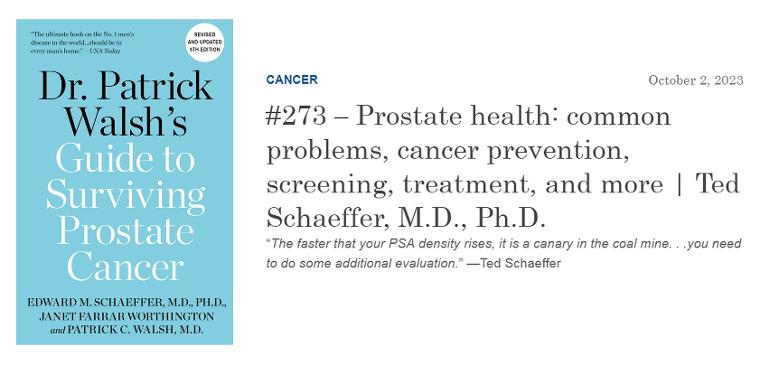Two recent resources that all PCa patients should take the time to get/use/access. The first is the 2023 updated edition of the patient guide, Dr. Patrick Walsh's Guide to Surviving Prostate Cancer. And the second is a Dr. Peter Attia podcast interview with Ed Schaeffer, MD & PhD from October of 2023.
Dr. Patrick Walsh's book, a true classic guide for patients, was initially written by him over two decades ago. As the the originator of the nerve-sparing prostatectomy procedure that has been in use for most radical prostatectomies for the last several decades, he has helped to save the lives and sexual/urinary functions for countless men with PCa. As I remember it described in an article from around the time of my RALP (2013), every surgeon doing prostatectomies in the US (at that time) had either trained under Dr. Walsh or under some other surgeon trained by him.
Dr. Ed Schaeffer was instrumental in the recent update to Walsh's book and is one of those people who trained under Dr. Walsh. He now heads up the Urology Department at Northwestern University in Evanston, Illinois. According to Dr. Schaeffer, about 1/3 of this 2023 update is completely new information, so those using the older version, would surely benefit by reading this newer edition. Here is what the "third author" of the book had to say in her Introduction:
* * *
"This is a book written by two of the world’s foremost and best experts on prostate cancer: Edward (“Ted”) Schaeffer, a great surgeon-scientist, trained at Johns Hopkins by Patrick Walsh and now head of the Department of Urology at Northwestern University; and Patrick Walsh, the great Johns Hopkins surgeon-scientist who invented the nerve-sparing radical prostatectomy and developed a field-changing prostate cancer research program at Johns Hopkins. Dr. Schaeffer has developed further modifications to this procedure to preserve urinary continence and potency and has created his own world-class prostate cancer research and treatment program at Northwestern. He is now the lead author of the book."
* * *
The Peter Attia podcast (The Drive) with the same Dr. Schaeffer quickly affirms the comprehensive knowledge that he brought to the update of the Walsh book. The podcast, like many these days, is very long at 15 mins short of 4 hours. The topic coverage is also comprehensive and should serve as an educational and treatment help-service for anyone who will take the time to view it. I have now listened to it numerous times and always find something worth repeating or missed in previous listenings. (As we have some self-appointed pundits on PCa forums who disdain the use of YouTube or other videos for disseminating information on medical issues in general and PCa in specific, I challenge them to demonstrate any source of information that can come close to the width and depth displayed in this video by two exceptionally credentialed and seasoned practicing MDs, both at the top of their respective areas of interest/specialization.)
Here is a link to the 2023 edition of Dr. Walsh's book:
Dr. Patrick Walsh’s Guide to Surviving Prostate Cancer, Copyright © 2001, 2007, 2012, 2023 by Patrick C. Walsh, Janet Farrar Worthington, and Edward Matthew Schaeffer
amazon.com/Patrick-Walshs-S...
And links to both PA's Drive podcast site and the complete interview @ YouTube:
273 ‒ Prostate health: common problems, cancer prevention, screening, treatment, and more
peterattiamd.com/tedschaeff...
Full video via YouTube:
youtube.com/watch?v=poTcAm_...
Both resources will help you stay S&W,
Ciao - cujoe
PS Peter Attia has numerous videos on a range of health and fitness issues at his website and on his YouTube Channel. Highly recommended as a source of high quality information.
